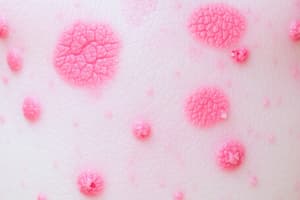Podcast
Questions and Answers
What is the primary characteristic of atopic dermatitis?
What is the primary characteristic of atopic dermatitis?
- Excessive sweating
- Nodules
- Pruritus (correct)
- Hyperpigmentation
In the context of atopic dermatitis, what does 'Atopic March' refer to?
In the context of atopic dermatitis, what does 'Atopic March' refer to?
- Advancement of dermatitis with age
- Seasonal changes in eczema severity
- Progression of allergic disorders (correct)
- Improvement of skin with external treatment
Which of the following is a common complication of atopic dermatitis?
Which of the following is a common complication of atopic dermatitis?
- Secondary skin infections (correct)
- Decreased sensitivity to allergens
- Increased sweat production
- Decreased risk of asthma
A patient with atopic dermatitis has developed small, fluid-filled blisters on their hands and fingers. Which specific type of eczema is the MOST likely cause?
A patient with atopic dermatitis has developed small, fluid-filled blisters on their hands and fingers. Which specific type of eczema is the MOST likely cause?
The pathogenesis of atopic dermatitis involves alterations in the skin barrier and immune system. Which of the following BEST describes the skin barrier dysfunction?
The pathogenesis of atopic dermatitis involves alterations in the skin barrier and immune system. Which of the following BEST describes the skin barrier dysfunction?
Which of the following best describes the clinical presentation of childhood eczema related to atopic dermatitis?
Which of the following best describes the clinical presentation of childhood eczema related to atopic dermatitis?
What is a typical feature of atopic dermatitis manifestation known as Keratosis Pilaris?
What is a typical feature of atopic dermatitis manifestation known as Keratosis Pilaris?
A patient presents with lichenification due to chronic atopic dermatitis. What skin changes are MOST characteristic of lichenification?
A patient presents with lichenification due to chronic atopic dermatitis. What skin changes are MOST characteristic of lichenification?
Which of the following is a diagnostic criterion for atopic dermatitis, according to the Hanifin and Rajka criteria?
Which of the following is a diagnostic criterion for atopic dermatitis, according to the Hanifin and Rajka criteria?
What is the common treatment approach for managing atopic dermatitis?
What is the common treatment approach for managing atopic dermatitis?
What precentage of children are affected by atopic dermatitis worldwide?
What precentage of children are affected by atopic dermatitis worldwide?
Which of the following is usually NOT an allergy to any one thing and is rather a supersensitivity to a variety of triggers?
Which of the following is usually NOT an allergy to any one thing and is rather a supersensitivity to a variety of triggers?
If a family has a history of atopic dermatitis, what factors increase the risk of a family member contracting atopic dermatitis?
If a family has a history of atopic dermatitis, what factors increase the risk of a family member contracting atopic dermatitis?
At what age does Atopic Dermatitis usually onset?
At what age does Atopic Dermatitis usually onset?
A parent asks if their child will have atopic dermatitis for life, what is the correct answer?
A parent asks if their child will have atopic dermatitis for life, what is the correct answer?
How is Atopic Dermatitis diagnosed?
How is Atopic Dermatitis diagnosed?
What percentage of children with Atopic Dermatitis will develop another atopic disease?
What percentage of children with Atopic Dermatitis will develop another atopic disease?
True or False: Atopic Dermatitis is often predictable.
True or False: Atopic Dermatitis is often predictable.
Which of the following can Atopic Dermatitis effect?
Which of the following can Atopic Dermatitis effect?
Where is Atopic Dermatitis rare?
Where is Atopic Dermatitis rare?
Which of the following conditions are included in the "Atopic Triad"?
Which of the following conditions are included in the "Atopic Triad"?
True or False: History of pruritis (hallmark!) is a clinical profile of Atopic Dermatitis.
True or False: History of pruritis (hallmark!) is a clinical profile of Atopic Dermatitis.
Which of the following can be a sign or symptom of Atopic Dermatitis?
Which of the following can be a sign or symptom of Atopic Dermatitis?
What is a hallmark of the skin related to the pathogenesis of Atopic Dermatitis?
What is a hallmark of the skin related to the pathogenesis of Atopic Dermatitis?
In infants, where does eczema typically occur?
In infants, where does eczema typically occur?
Select which is the most common cause of secondary bacterial infections to the skin:
Select which is the most common cause of secondary bacterial infections to the skin:
A patient is suspected of having Atopic Dermatitis, according to the diagnostic criteria to make a diagnosis how many major and minor criteria should there be?
A patient is suspected of having Atopic Dermatitis, according to the diagnostic criteria to make a diagnosis how many major and minor criteria should there be?
What are some different management strategies for Atopic Dermatitis?
What are some different management strategies for Atopic Dermatitis?
For secondary bacterial infections to the skin for Atopic Dermatitis, which anti-biotic should be used?
For secondary bacterial infections to the skin for Atopic Dermatitis, which anti-biotic should be used?
Flashcards
Atopic Dermatitis
Atopic Dermatitis
A chronic inflammatory skin disease, known as 'the itch that rashes'.
Atopic Dermatitis Risk Factors
Atopic Dermatitis Risk Factors
Risk factors include family history, genetics, and environmental factors.
Atopy
Atopy
It denotes a form of allergy; its role in Atopic Dermatitis is unclear.
Diagnosing Atopic Dermatitis
Diagnosing Atopic Dermatitis
Signup and view all the flashcards
Secondary Skin Infections (Impetigo)
Secondary Skin Infections (Impetigo)
Signup and view all the flashcards
Infantile Eczema
Infantile Eczema
Signup and view all the flashcards
Childhood Eczema
Childhood Eczema
Signup and view all the flashcards
Lichenification
Lichenification
Signup and view all the flashcards
Nummular Eczema
Nummular Eczema
Signup and view all the flashcards
Pityriasis alba
Pityriasis alba
Signup and view all the flashcards
Allergic Shiners
Allergic Shiners
Signup and view all the flashcards
Keratosis Pilaris
Keratosis Pilaris
Signup and view all the flashcards
Atopic Dermatitis - Management
Atopic Dermatitis - Management
Signup and view all the flashcards
Risk factors of Atopic Dermatitis?
Risk factors of Atopic Dermatitis?
Signup and view all the flashcards
What is Pruritis?
What is Pruritis?
Signup and view all the flashcards
Pathogenesis of Atopic Dermatitis?
Pathogenesis of Atopic Dermatitis?
Signup and view all the flashcards
What is the Atopic Triad?
What is the Atopic Triad?
Signup and view all the flashcards
Secondary Viral Infection
Secondary Viral Infection
Signup and view all the flashcards
Study Notes
- Atopic Dermatitis also known as Eczema
- Atopic dermatitis is a chronic inflammatory skin disease known as "The itch that rashes".
- Atopic dermatitis rash Pruritic, Superficial, Chronic, Scaly, Excoriation
- Hallmark symptom is Pruritus (itching).
- Atopic Dermatitis is most common inflammatory skin disease in children and adults, affecting 15%-20% of children worldwide.
- Specifice etiology is unclear.
- It is usually not an allergy to one thing. It is a supersensitivity to triggers that are irritant in nature.
Risk Factors and Onset
- Risk factors include family history, genetics, and environment.
- Atopy denotes a form of allergy and the role of allergies is unclear in Atopic Dermatitis.
- Onset is commonly after 2 months of age; 85% of cases occur by age 1 and 95% by age 5. Onset after puberty = higher risk for life-long involvement.
- About 30% of cases may advance from childhood to adolescence.
- Age-related patterns include Infantile eczema, Childhood eczema, Adolescent/Adult eczema.
- Many pediatric patients "outgrow" Atopic dermatitis and the condition gets better over time.
Diagnosis and Development
- Diagnosis is based primarily on Clinical Manifestations.
- There is No definitive laboratory test to diagnose Atopic Dermatitis.
- Atopic Dermatitis generally improves with age; about 40% clear by age 3 and about 70% by puberty.
- About 50% to 80% of children with Atopic Dermatitis will develop another atopic disease.
- Atopic Dermatitis frequently relapses (flare-ups and remissions), but is not often predictable.
- It may have an adverse impact on quality of life and emotional health of children; interferes with sleep and school performance.
Complications
- A common complication is secondary skin infections (impetigo), most commonly caused by Staphylococcus aureus (>80%).
- It is 40% associated with food allergies (nature of association is unclear).
- It is rare in the diaper area; if eczema is seen in diaper area, it is suggestive of food allergies.
- Atopic Triad consists of Atopic Dermatitis, Asthma, and Allergic Rhinoconjunctivitis.
- Atopic March is a progression of allergic disorders as a patient develops multiple allergic conditions with age, including food allergies, allergic rhinitis, and asthma, with atopic dermatitis as the initial feature.
Clinical Profile
- History of pruritis is a hallmark.
- Family history of allergies is a factor.
- Appearance of lesions: scaly, dry, lichenified
- Distribution of rash: flexural vrs extensor
- Lesion onset and duration: childhood onset vrs adult onset
- Signs/Symptoms: pruritis; scratching; rubbing; irritation; erythema; papules; vesicles; lichenification; excoriation.
Pathogenesis
- Faulty epidermal barrier results in mutations + deficiency in filaggrin along with a decrease in ceramides and transdermal water loss.
- Immune dysregulation causes alterations in cutaneous innate + adaptive immunity.
- Defective neutrophil and monocyte chemotaxis with Abnormal T cell function.
- Type 2 Inflammation (80%): is an immune system overreaction to non-threats; involves Basophils, Mast cells + T-helper Type 2 cells that produce Type 2 Cytokines -> induce inflammation.
- Elevated immunoglobulin E (IgE) – in about 80% of cases.
- Family history of allergy is a factor (first-degree relative with asthma or allergic rhinitis)
- Environmental triggers include cold and dry weather, house dust mites, pet fur, pollen, molds, and food allergens (cows milk, peanuts, soya, wheat)
Infantile Eczema
- Eczema in infants usually has an onset at 2 months of age.
- Location: extensor surfaces of arms and legs; cheeks, forehead; scalp
- It spares moist folds of skin and diaper area typically.
- Intensely pruritic and irritable papules that unable to scratch effectively, scratching leads to persistent, erythematous, scaling, oozing, crusty plaques
- Infant often has a history of seborrheic dermatitis ("cradle cap"), scaly!
Childhood Eczema
- Childhood eczema occurs from 2 years to puberty/adolescence
- Usually flexural (antecubital and popliteal fossae); wrists; ankles; posterior neck.
- Facial presentation: periorbital and perioral
- May result in lichenification and pigmentary changes; follicular.
- Secondary bacterial infections may occur, with lymphadenopathy.
Adolescent/Adult Eczema
- Lichenification ("leathery appearance") is common.
- Rash distribution is predominantly flexural (antecubital and popliteal); dorsal aspects of hands and feet; face; nape of neck; lips.
- Follicular post-inflammatory hyperpigmentation is prominent at the adolescent stage.
- Keratosis pilaris ("goose-bump" feel to skin) common in adults
Pityriasis Alba Manifestation
- Pityriasis alba is superficial scaly macules (slight/yellowish hypopigmentation); patches over the cheeks and extensor surfaces; symmetrical distribution.
- It is a common feature of Atopic Dermatitis.
Allergic Shiners Manifestation
- Allergic shiners are darkened, mildly erythematous or tanned periorbital areas, bilaterally and symmetrically.
- It is typically a feature in Atopic Dermatitis.
Keratosis Pilaris Manifestation
- Keratosis pilaris represents a sparse or confluent distribution of follicular papules (grainy feel when rubbed lightly)
- It is often seen symmetrically on dorsal upper arms (extensor surfaces) or on the trunk.
- More common in adults and often symmetrical in distribution.
Lichenification Manifestation
- Lichenification is skin thickening and exaggeration of normal skin markings ("leathery patches")
- Seen at popliteal fossa and antecubital fossa (flexural surfaces) symmetrically.
- Is often a consequence of the "itch-scratch cycle" and is associated with subacute/chronic eczema.
- Hyperpigmentation is quite evident in patients with darker skin.
- Epidermis: abnormal accumulation of keratinocytes; (parakeratosis) + thickening of skin - leathery (acanthosis). Dermis: inflammatory cell infiltrates.
Nummular Eczema Manifestation
- Nummular eczema is dry “coin-lack" patches; sparsely distributed on extremities, and trunk with itchiness.
Dennie-Morgan Folds Manifestation
- Periorbital eczema.
- Dennie-Morgan folds = infraorbital folds in the skin below the eyelids.
- Varying severity, a mild form referred to as "Dennie's pleats"
Other Manifestations
- Atopic cheilitis (lip-smacking eczema) is perioral eczema.
- Thumb-sucking Eczema - eczematous with dryness, cracking, calluses.
- Hyerlinear palms
- Spares diaper area
Dyshidrotic Eczema Manifestation
- Dyshydrotic eczema is characterized by fluid-filled blisters appearing on the hands and fingers.
- It usually lasts about 3 weeks and is very dry and pruritic.
- Treatment: Corticosteroids, Phototherapy, and Moisturizers.
- The cause is unknown, although often associated with allergies and stress. Linked to Vit D deficiency.
Secondary bacterial infection
- Secondary bacterial infection (Impetigo) is the most common complication of Atopic dermatitis.
- Staphylococcus aureus is the most common cause of secondary bacterial infections in Atopic Dermatitis;
- Staphylococcus aureus produces toxins that trigger flare-ups.
- Impetigo can develop further into Cellulitis.
Secondary Viral Infection
- Eczema Herpeticum (Kaposi Varicelliform Eruption) is a secondary viral infection in Atopic Dermatitis,
- It is commonly caused by Herpes Simplex virus.
- The lesions are typically on the face, commonly occurs in infants.
- Note: This is different from Dermatitis herpetiformis, a rare persistent immunobullous disease associated with Gluten-sensitive enteropathy (Celiac Disease).
Major Diagnostic Criteria for Atopic Dermatitis
- There needs to be 3 major and 3 minor criteria
- Pruritis (persistent)
- Distribution (Flexural (adult)/Extensor + face (infant)
- Rash (chronic/relapsing)
- Atopy (Personal/Family history).
- Commonly referred to as Hanin and Rajka Criteria.
Minor Diagnostic Criteria
- Atopic facies: Pityriasis alba; facial erythema; allergic shiners; Dennie's pleats; Cheilitis; neck folds; recurrent conjunctivitis.
- Triggers: Foods; emotions; environment; skin irritants
- Complications: secondary skin infections; impaired cell-mediated immunity; skin test reactivity; Elevated IgE; Keratoconus (bulging of cornea); Cataracts
- Others: Early age of onset; Xerosis (dry skin); ichthyosis; hyperlinear palms; keratosis pilaris; hand/foot dermatitis; nipple eczema; white dermatographism; folliculitis.
Management
- Moisturizers like Eucerin, Cetaphil, Aquaphor
- Topical Corticosteroids such as Hydrocortisone, Fluticazone (Cutivate) vary in potencies.
- Topical Non-steroidal Immunomodulators such as Topical Tacrolimus (Protopic) and Pimecrolimus (Elidel) are reserved for > 2y.o.; if unresponsive to standard therapy.
- Antihistamines such as Hydroxyzine (Atarax) Citrazine (Zyrtec) and Loratidine (Claritin) are used for pruritis.
- Antibiotics such as Cephalexin (Keflex), Clindamycin or Doxycycline treat secondary bacterial infections.
- Systemic Immunosuppressants such as Cyclosporine are for severe refractory Atopic Dermatitis.
- Anticipatory Guidance (verbal advice) along with a Written Action Plan is key.
- Avoid Triggers
- Gentle/Sponge bathing (e.g. non-fragrant soaps) is useful.
Differential Diagnosis
- Atopic Dermatitis
- Scabies
- Varicella-Zoster (Chicken pox)
- Seborrheic dermatitis
- Allergic contact dermatitis
- Contact Irritant dermatitis
- Drug reaction
- Insect bite
- Impetigo
- Rhus dermatitis (Poison ivy)
- Xerosis
- Ichthyosis vulgaris
- Acrodermatitis enteropathica (Zinc deficiency)
- Dyshydrotic eczema
- Wiskott-Aldrich syndrome (rare; X-linked; Immunodeficiency, Eczema Thrombocytopenia)
Studying That Suits You
Use AI to generate personalized quizzes and flashcards to suit your learning preferences.




